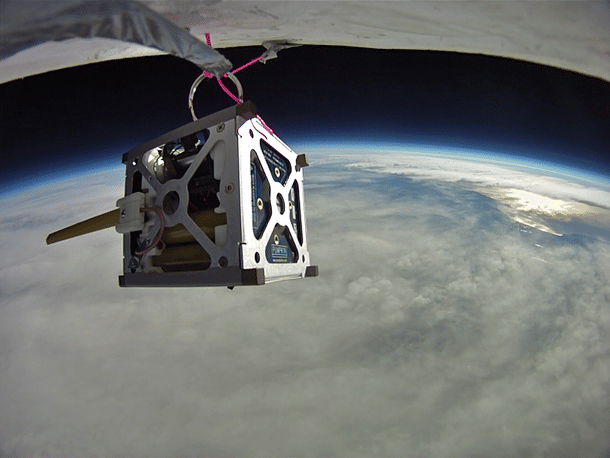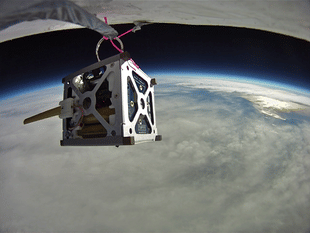Science
Explained: What Are CubeSats and Why They Are Taking Off In The Satellite Market
Srikanth Ramakrishnan
Feb 17, 2017, 07:35 PM | Updated 07:35 PM IST
Save & read from anywhere!
Bookmark stories for easy access on any device or the Swarajya app.


Cube Satellites, or CubeSats, have been in the news for a while now, especially since the Indian Space Research Organisation (ISRO) launched 101 CubeSats of the 104 recently. Here, we explain what CubeSats are and why they are significant.
CubeSats, as the name suggests, are nearly cubical-sized satellites, often in multiples of size 10×10×11.35cm, and using commercially available components. They came up in the late 1990s as part of a collaborative programme between California Polytechnic State and Stanford Universities to create a standard for pico satellites. By 2012, 75 of these satellites were placed in orbit.
Because of the availability of low-cost, programmable computers such as the Raspberry Pi, anyone with a basic idea of programming can initiate a CubeSat production. National Aeronautics and Space Administration’s PiSat programme has encouraged production by inviting people to ideate and work on small satellites based on the Raspberry Pi platform. The United Kingdom Space Agency also has an Astro-Pi programme, where students could contribute to building a pico satellite using the Raspberry Pi platform.
Closer home, Bengaluru-based PES University has launched its PISAT nano satellite programme, although it was not based on a CubeSat platform. Designed and built by students and professors of the university, the satellite made it into space aboard an ISRO launch vehicle. Companies like Pumpkin Inc sell ready-to-use Skeletons for CubeSat designs that can be used in space. Students at the Mektory Space Centre in Tallinn, Estonia, are even making CubeSats using a 3D printer.
How does the CubeSat function?
Due to its small size, CubeSats incorporate a wide variety of designs to stay afloat in space. They may use cold gas thrusters, wherein a pressurised can pumps out an inert gas to provide the thrust, or use more modern systems such as electric propulsion or solar sails.
Electric propulsion drives the satellite using electric current while solar sails make use of radiation pressure and ultra-thin mirrors for the purpose. The satellites are powered using solar panels, like most space vehicles, stored in Lithium-ion batteries which power all the systems and provide backup during eclipse periods.
Why are CubeSats important?
The answer to this question lies in the nature of CubeSats themselves. They are small, compact, easy to design and build, and cheap to implement. As more and more research on improving the efficiency of the propulsion system comes in, the satellites become cheaper and more efficient with each passing day.
CubeSats allow operations to be decentralised. In place of a single large satellite, multiple smaller satellites can be used. The major advantage of this is reliability. If a technical failure or debris in space takes out any component of a satellite, the whole satellite is rendered useless. This is exactly what happened to India’s first lunar probe Chandrayaan-1, where ISRO lost all contact to the satellite 310 days after it had been in orbit.
Of the 101 CubeSats launched by the PSLV-C37 this week, 88 of them belonged to one company: Planet Labs. An Earth-imaging company based out of San Francisco, it operates multiple “Flock” satellites, notably the Flock-2p, launched by ISRO’s PSLV-C34 and Flock-3p, launched last week. With over a hundred Flock units “flocking around” in space, Planet Labs is able to provide high-resolution imagery from across the world to various clients, to the extent that Google sold its SkySat constellation and entered into an agreement with Planet Labs for its imagery.
CubeSats have great potential in security applications as well. Due to the presence of many rogue groups in India’s neighbourhood, it would bode well for the country to develop a satellite constellation to keep an eye on its aggressive neighbours as well as monitor the area during counter-terrorist operations. So if one satellite goes down, for instance, the remaining satellites remain in space rather than meet with the fate of Chandrayaan-1.
Described as a satellite in a shoebox, the CubeSat’s biggest achievement is that it has enabled students and researchers to work on projects that were hitherto not available to them. Today, many universities across the globe are encouraging students into developing CubeSats, a programme that is working mainly due to the commercially-available components. This is, in essence, similar to Elon Musk’s SpaceX (also in the CubeSat development sphere) holding design competitions for students to design pods for the Hyperloop. Getting more research done in a field is the most successful way to making the technology mainstream.
Research into CubeSats covers a lot of sectors. It involves scaling down components, reducing component size while maintaining efficiency, making the thrust system more efficient, developing more efficient batteries and solar cells, and of course, improving imaging systems. The resulting real-world applications are huge outside the ambit of space exploration.
These technology developments can go a long way in improving our quality of life as well. The thrust system can help in transport-based applications while the solar-based power system is something we need, thanks to the dwindling reserves of fossil fuels. The imaging technology can make its way into the medical field to help identify life-threatening illnesses much faster. The possibilities are endless.
India has ample potential in the area of CubeSat development. With a large student base, especially engineers, we can easily start research and development into this. Since India already has a successful space programme, it should not shy away from initiating a programme of this sort. Universities need to start competitions for design, and the Department of Space should incentivise the process. In India, CubeSats can have a wide variety of uses. They can be used in various fields ranging from navigation to traffic control. They can even aid drones in anti-insurgency operations.
NASA plans to send its Lunar IceCube to the Moon in 2018 to study water deposits. ISRO should learn from this mission for Chandrayaan-2 and consider sending a CubeSat as well. Gone are the times of sending large, clunky satellites into space. The Cubes are in, and they’re here to stay.
Srikanth’s interests include public transit, urban management and transportation infrastructure.





